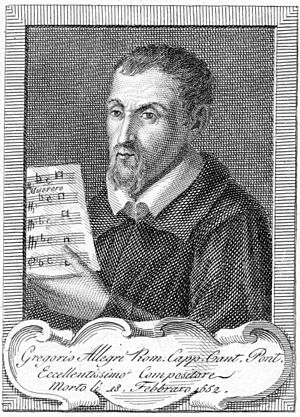Gregorio Allegri facts for kids
Quick facts for kids
Gregorio Allegri
|
|
|---|---|

Gregorio Allegri
|
|
| Born | 1582 |
| Died | 7 February 1652 Rome
|
| Occupation | Priest and composer |
Gregorio Allegri (1582 – February 7, 1652) was an Italian composer and priest. He wrote many religious songs, including motets and different versions of the Mass. His most famous piece of music is called Miserere mei Deus.
Allegri started working in a church choir in Rome when he was young, from 1591 to 1596. By 1601, he became a tenor singer in the choir. He learned about music and composing from the choir's director, G. B. Nannio. Allegri worked in several churches around Rome. In 1629, he joined the famous choir at the Vatican. This choir performed in the Sistine Chapel for the pope. In 1650, he became the director of this important choir.
Pope Urban VIII had changed some of the words used in church services. Allegri was asked to update the music of another famous composer, Giovanni da Palestrina, to fit these new words. Allegri was known for understanding older music styles very well. However, he also wrote some of his own music in the newer, more exciting Baroque style.
Contents
About Miserere mei Deus
Miserere mei, Deus is a special song called a motet. It was written to be sung by two separate choirs at the same time. One choir has five voices: a soprano, an alto, two tenors, and a bass. The second choir has four voices: two sopranos, an alto, and a baritone.
One choir sings a simple tune called a fauxbourdon. This tune is based on an old church song known as a plainchant. The other choir sings a more complex version. It has a very high part that goes up to a top C note. This note is two octaves higher than Middle C. The singers also added their own parts to the music as they sang. They would make up fancy, decorated sections. These parts were not written down. Instead, they were taught from one singer to another within the choir.
The Secret Music of the Vatican
Allegri wrote the Miserere to be sung in the Sistine Chapel. This happened during the Easter celebrations. The service would begin very early, at 3:00 AM. There were 27 candles burning during the service. The Pope would slowly put out the candles one by one. Eventually, only one candle would be left burning. The Miserere was performed as the Pope prayed at the altar with that single candle.
This piece of music became very popular. The Vatican wanted to keep it special. They did not want anyone else to perform it outside the chapel. No one was allowed to take the music away or make copies. The Vatican even said they would excommunicate (kick out of the church) anyone who tried to copy it.
However, by 1770, three copies of the music were known to exist. One copy was given to Emperor Leopold I by the Pope himself.
Mozart's Amazing Memory
In 1770, Wolfgang Amadeus Mozart visited the Sistine Chapel. He was only 14 years old and was touring Europe with his father. Mozart heard the Miserere being performed. Later that same day, he wrote down the entire piece of music from memory! He visited again to check his work and make sure it was correct.
It is believed that Mozart's copy of the music was sent to England. There, it was published by a man named Dr. Charles Burney. Mozart's copy would have included the special improvised parts. However, Burney's published version does not have these improvisations. It is possible that Burney removed them. He might have even destroyed Mozart's original copy to avoid trouble with the church. There were no copyright laws back then, so the Vatican could not legally stop copies from being made.
Today, many people believe that the version of Miserere mei Deus performed now is quite different from what Allegri originally composed.
Images for kids
See also
 In Spanish: Gregorio Allegri para niños
In Spanish: Gregorio Allegri para niños


